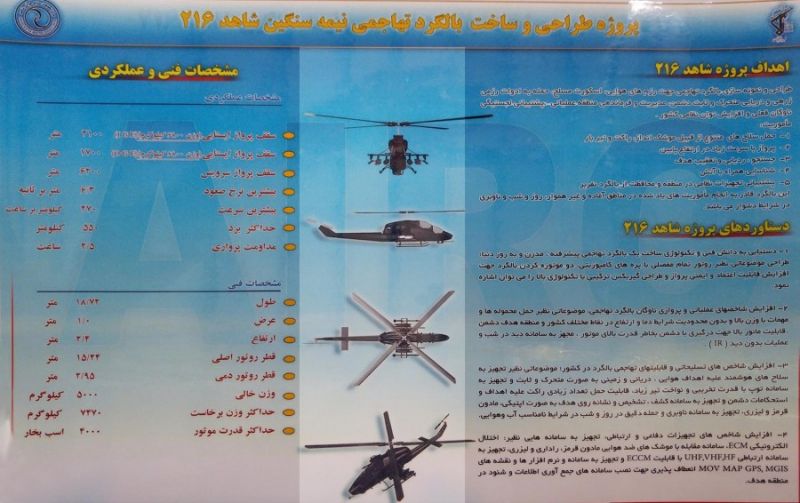 Реклама Google — средство выживания форумов :)
Реклама Google — средство выживания форумов :)
-
![[image]](https://www.balancer.ru/cache/sites/com/av/aviashots/aviation-photos/big/128x128-crop/1001269.jpg)
На что способны ВВС Ирана сегодня
IRIAF и, по пожеланиям, ПВОТеги:
с.т.> интересно почему они не купят ещё свежих самолётов а продолжают музейные экспонаты упорно эксплуатировать
Так санкции вот-вот сняли, да и снятие вроде идет постепенно. Плюс сами на базе F-5 пытаются в серию запустить машину. Так что факторов много. Думаю что купят, но позже.
Так санкции вот-вот сняли, да и снятие вроде идет постепенно. Плюс сами на базе F-5 пытаются в серию запустить машину. Так что факторов много. Думаю что купят, но позже.


с.т.> интересно почему они не купят ещё свежих самолётов а продолжают музейные экспонаты упорно эксплуатировать
Как бы чтобы купить свежих самолетов, в частности нужны деньги. А военный бюджет у них сокращается, да и не такой он уж и большой.
Это если отбросить остальные причины и резоны.
Как бы чтобы купить свежих самолетов, в частности нужны деньги. А военный бюджет у них сокращается, да и не такой он уж и большой.
Это если отбросить остальные причины и резоны.


Еще один МиГ-29 подняли. Правда непонятно какой - на кадрах то обычный, то УБ. Но тем не менее - +1:


По ссылке много фото, и боевых и транспортников, авиашоу на 4-й базе ВВС Ирана около Дизфула:


Дизфуль-2016
Фотографии и видео с очередного авиашоу на 4-й тактической авиабазе около г.Дизфул, что уже много лет проходят там. F-14 МиГ-29 F-4 Су-24 Saeghe F-7 CH-47 Bell-214 Pilatus PC-6 Pilatus PC-7 C-130… // imp-navigator.livejournal.com
Прикреплённые файлы:


F-14A (возможно AM) в новом камуфляже:
Прикреплённые файлы:


Saeghe - не понятно налажен ли серийный выпуск. Скорее всего нет, массовых поступлений в ВВС не наблюдается пока:
Прикреплённые файлы:


И даже вот такие редкости как Pilatus PC-6:
Прикреплённые файлы:


Sergofan> Saeghe - не понятно налажен ли серийный выпуск. Скорее всего нет, массовых поступлений в ВВС не наблюдается пока:
Вроде как пишут ,что и не было как такового серийного производства. Все построенные машины есть суть переделка строевого F-5. Преимуществ по сравнению с Ф-5 нет, наоборот появились ухудшения в управляемости на больших углах по крену. Карочь фигня эт всё.
Вроде как пишут ,что и не было как такового серийного производства. Все построенные машины есть суть переделка строевого F-5. Преимуществ по сравнению с Ф-5 нет, наоборот появились ухудшения в управляемости на больших углах по крену. Карочь фигня эт всё.


Новое слово в ПВО Ирана  57-мм ЗСУ Bahman (на заднем плане)! Которое на самом деле есть башня от старой списанной ЗСУ-57 на шасси КрАЗ-6322:
57-мм ЗСУ Bahman (на заднем плане)! Которое на самом деле есть башня от старой списанной ЗСУ-57 на шасси КрАЗ-6322:
 57-мм ЗСУ Bahman (на заднем плане)! Которое на самом деле есть башня от старой списанной ЗСУ-57 на шасси КрАЗ-6322:
57-мм ЗСУ Bahman (на заднем плане)! Которое на самом деле есть башня от старой списанной ЗСУ-57 на шасси КрАЗ-6322:
Прикреплённые файлы:


Оно же покрупнее:
Прикреплённые файлы:


Это учения КСИР. Но т.к. оно летает и стреляет - то помещу сюда. Немного "Кобр" КСИР досталось, вот одна из них производит пуск НУРС:
Прикреплённые файлы:


В одном строю:
Прикреплённые файлы:


Эти тоже есть у КСИР:
Прикреплённые файлы:


ПВО КСИР, кстати половина ПВО Ирана - Зу-23-2:
Прикреплённые файлы:


B.S.> Вертушки времён Вьетнама...70-е годы прошлого века. И поди ж ты - летают...
Они капиталят даже те, что в годы ирано-иракской повреждения получили, но смогли хоть как-то сесть. Вообще орлы иранские инженеры, как есть орлы.
Кстати вот еще, забыл. Проект ударного вертолета, пока только в картинках:
Они капиталят даже те, что в годы ирано-иракской повреждения получили, но смогли хоть как-то сесть. Вообще орлы иранские инженеры, как есть орлы.
Кстати вот еще, забыл. Проект ударного вертолета, пока только в картинках:
Прикреплённые файлы:


Sergofan> Кстати вот еще, забыл. Проект ударного вертолета, пока только в картинках
Смешной иранский стелс-самолетик... в пластилине - Qaher F-313
Последняя фраза статьи: "Как это руководство Ирана понадеялось выставить на обозрение всего мира такую туфту и не навлечь на себя презрительную издевку со всех сторон."
Вся иранская военная техника - это каменный век!

The Qaher F-313 was suppose to be Iran's first stealth fighter—but it seems like it was all a big hoax.
// nationalinterest.org
Whatever Happenned to Iran's Super Stealth Fighter?
Dave Majumdar April 1, 2016
Several years back, Iran rolled out its Qaher F-313 ‘stealth fighter’ in front of then President Mahmoud Ahmadinejad. Within hours it was met with near universal derision from defense and aerospace experts around the world.
While almost everyone outside Iran saw the project for the farce that it was,Tehran insisted that the project was real and that it was already flying. Further, the Iranian government insisted that the bizarre-looking aircraft—which was allegedly superior to the Lockheed Martin F-22 Raptor and the F-35 Joint Strike Fighter—would become operational in the very near future. But since then the project has disappeared. So, whatever happened to Iran’s impressive plans for the Qaher F-313 stealth fighter?
The answer is nothing—as with much of Iran’s bluster—the Qaher F-313 was a ham-handed hoax. Even at the time when Iran first showed off the Qaher, it was clear that the mockup was little more than a poorly executed propaganda stunt engineered for domestic consumption.
From even a cursory examination of the many photos and video imagery of the aircraft with a purportedly ‘very small radar cross section,’ it was immediately apparent that this was not a serious development. At the very best, it is a subscale test-bed.
Perhaps the most immediate give away was the miniscule size of the craft. There didn’t appear to be room for avionics and fuel—let alone weapons. Moreover, it’s doubtful that there was an engine installed given the lack of a nozzle and the two tiny air inlets.
The other problem for Iran would have been to find an engine small enough to fit into such a miniscule airframe. Tehran’s options seem limited to something like the General Electric J85—which Iran has previously reverse engineered—but without a nozzle the heat would have likely set this mock-up ablaze.
Additionally, the cockpit appeared to be too small in relation to the pilot. And the visibility through the material could only be described as horrendous.
The cockpit instruments were amongst the only items in the Qaher F-313 that could be described as real. The Iranians were using instrumentation developed for the home-build aircraft market with hardware sourced from Dynon and Garmin.
Furthermore, there were no access panels or weapons bays that were visible. Features such as access panels are found on every aircraft for routine maintenance. In the case of a stealth aircraft, internal weapons bays are necessary in order maintain the jet’s low observable signature while carrying armaments. But as one engineer familiar with low observables design astutely pointed out at the time, while superficially resembling what one might imagine a stealth aircraft to look like, the Iranian machine had serious radar cross section (RCS) problems.
Stealth aircraft design is much more involved than simply mastering the low observable shapes. There are advanced materials sciences that need to be developed for the aircraft’s skin and coatings. Advanced analytical tools are needed to shape the internal bulkheads and other structures. Moreover, one has to master the man-machine interfaces so that a pilot can manage the aircraft’s RCS spikes in flight. There is no evidence—now or back in 2013—that suggests that Iran has mastered those technologies.
So where is the Qaher F-313? It was spotted only once after its initial debut in November 2013 being prepped for taxi tests—but it has never been seen again. It’s likely the unimpressive mockup is sitting in the warehouse somewhere in Iran, or has been recycled for some other theatrical production.
The real mystery is—as it was then—how Iran’s leaders might assume that they could present such a farce before the eyes of the world and not invite anything other than mockery.
Dave Majumdar is the defense editor for the National Interest. You can follow him on Twitter: @davemajumdar
Смешной иранский стелс-самолетик... в пластилине - Qaher F-313
Последняя фраза статьи: "Как это руководство Ирана понадеялось выставить на обозрение всего мира такую туфту и не навлечь на себя презрительную издевку со всех сторон."
Вся иранская военная техника - это каменный век!

Whatever Happened to Iran's Super Stealth Fighter?
The Qaher F-313 was suppose to be Iran's first stealth fighter—but it seems like it was all a big hoax.
// nationalinterest.org
Whatever Happenned to Iran's Super Stealth Fighter?
Dave Majumdar April 1, 2016
Several years back, Iran rolled out its Qaher F-313 ‘stealth fighter’ in front of then President Mahmoud Ahmadinejad. Within hours it was met with near universal derision from defense and aerospace experts around the world.
While almost everyone outside Iran saw the project for the farce that it was,Tehran insisted that the project was real and that it was already flying. Further, the Iranian government insisted that the bizarre-looking aircraft—which was allegedly superior to the Lockheed Martin F-22 Raptor and the F-35 Joint Strike Fighter—would become operational in the very near future. But since then the project has disappeared. So, whatever happened to Iran’s impressive plans for the Qaher F-313 stealth fighter?
The answer is nothing—as with much of Iran’s bluster—the Qaher F-313 was a ham-handed hoax. Even at the time when Iran first showed off the Qaher, it was clear that the mockup was little more than a poorly executed propaganda stunt engineered for domestic consumption.
From even a cursory examination of the many photos and video imagery of the aircraft with a purportedly ‘very small radar cross section,’ it was immediately apparent that this was not a serious development. At the very best, it is a subscale test-bed.
Perhaps the most immediate give away was the miniscule size of the craft. There didn’t appear to be room for avionics and fuel—let alone weapons. Moreover, it’s doubtful that there was an engine installed given the lack of a nozzle and the two tiny air inlets.
The other problem for Iran would have been to find an engine small enough to fit into such a miniscule airframe. Tehran’s options seem limited to something like the General Electric J85—which Iran has previously reverse engineered—but without a nozzle the heat would have likely set this mock-up ablaze.
Additionally, the cockpit appeared to be too small in relation to the pilot. And the visibility through the material could only be described as horrendous.
The cockpit instruments were amongst the only items in the Qaher F-313 that could be described as real. The Iranians were using instrumentation developed for the home-build aircraft market with hardware sourced from Dynon and Garmin.
Furthermore, there were no access panels or weapons bays that were visible. Features such as access panels are found on every aircraft for routine maintenance. In the case of a stealth aircraft, internal weapons bays are necessary in order maintain the jet’s low observable signature while carrying armaments. But as one engineer familiar with low observables design astutely pointed out at the time, while superficially resembling what one might imagine a stealth aircraft to look like, the Iranian machine had serious radar cross section (RCS) problems.
Stealth aircraft design is much more involved than simply mastering the low observable shapes. There are advanced materials sciences that need to be developed for the aircraft’s skin and coatings. Advanced analytical tools are needed to shape the internal bulkheads and other structures. Moreover, one has to master the man-machine interfaces so that a pilot can manage the aircraft’s RCS spikes in flight. There is no evidence—now or back in 2013—that suggests that Iran has mastered those technologies.
So where is the Qaher F-313? It was spotted only once after its initial debut in November 2013 being prepped for taxi tests—but it has never been seen again. It’s likely the unimpressive mockup is sitting in the warehouse somewhere in Iran, or has been recycled for some other theatrical production.
The real mystery is—as it was then—how Iran’s leaders might assume that they could present such a farce before the eyes of the world and not invite anything other than mockery.
Dave Majumdar is the defense editor for the National Interest. You can follow him on Twitter: @davemajumdar


Это сообщение редактировалось 17.04.2016 в 09:05
Bod:
предупреждение (+1) по категории «Обширная цитата на иностранном языке без перевода [п.16]»
- Bod [15.04.2016 21:39]: Предупреждение пользователю: Militarist#15.04.16 05:59
B.S.>> По вертушкам пулять в самый раз - никакие помехи не страшны... 
Sergofan> Помехи-то да... Но если обиженный вертолет ПТУРом засандалит этак с 4,7-4,5 км - ну как с видео работы наших машин из Сирии?..
Так ведь вертушки обычно на переднем крае обычно работают и в первую очередь охотятся за разными бронеобъектами.А этот экскаватор я как-то не могу представить рядом с танками.
Кстати,на дальности 4.5 км ЗСУ-57-2 теоретически могла попасть в вертолет

А вообще,без своего УАС( а откуда он в Иране) у этой бандуры своей ниши нет.ИМХО,разумеется

Sergofan> Помехи-то да... Но если обиженный вертолет ПТУРом засандалит этак с 4,7-4,5 км - ну как с видео работы наших машин из Сирии?..
Так ведь вертушки обычно на переднем крае обычно работают и в первую очередь охотятся за разными бронеобъектами.А этот экскаватор я как-то не могу представить рядом с танками.
Кстати,на дальности 4.5 км ЗСУ-57-2 теоретически могла попасть в вертолет

ЗЕНИТНАЯ САМОХОДНАЯ УСТАНОВКА ЗСУ-57-2
В 1947 году в НИИ-58 под руководством В.Г.Грабина приступили к проектированию спаренной 57-мм автоматической зенитной пушки С-68 на базе С-60, предназначавшейся как для установки на гусеничное шасси, так и на колесную повозку. Опытный ее образец с электроприодом ЭСП-76 был установлен на повозке С-79А и прошел испытания, но в серию не пошел. Гусеничное же шасси создали на базе агрегатов среднего танка Т-54. // Дальше — pvo.guns.ruА вообще,без своего УАС( а откуда он в Иране) у этой бандуры своей ниши нет.ИМХО,разумеется


И несмотря на неудачную (а когда было по-другому?  ) попытку тов. Милитариста засрать тему я продолжу. Парад, имитация дозаправки в воздухе. В группе танкер на базе 707-го, пара Томкэтов и один Фантом. На мой взгляд красиво:
) попытку тов. Милитариста засрать тему я продолжу. Парад, имитация дозаправки в воздухе. В группе танкер на базе 707-го, пара Томкэтов и один Фантом. На мой взгляд красиво:
 ) попытку тов. Милитариста засрать тему я продолжу. Парад, имитация дозаправки в воздухе. В группе танкер на базе 707-го, пара Томкэтов и один Фантом. На мой взгляд красиво:
) попытку тов. Милитариста засрать тему я продолжу. Парад, имитация дозаправки в воздухе. В группе танкер на базе 707-го, пара Томкэтов и один Фантом. На мой взгляд красиво:
Прикреплённые файлы:


Это сообщение редактировалось 17.04.2016 в 17:41
 Реклама Google — средство выживания форумов :)
Реклама Google — средство выживания форумов :)
Bronetemkin> Кстати,на дальности 4.5 км ЗСУ-57-2 теоретически могла попасть в вертолет
Теоретически - да, могла.
Bronetemkin> А вообще,без своего УАС( а откуда он в Иране) у этой бандуры своей ниши нет.ИМХО,разумеется
Согласен, это не их уровень. Но ниша есть. Эту штуку и ей подобные басиджам отдадут. Все не пропадать добру. А они рады и такому. Есть чему в небо пулять? Есть. Уже что-то.
ИМХО, по ПВО баиджей и КСИР Юрий Лямин мог бы пару диссертаций защитить Тема интересная, мало кому известная и малость нафталином пахнущая.
Тема интересная, мало кому известная и малость нафталином пахнущая.
Оффтоп. Ты чего-то совсем редко заходишь. Не теряйся
Теоретически - да, могла.
Bronetemkin> А вообще,без своего УАС( а откуда он в Иране) у этой бандуры своей ниши нет.ИМХО,разумеется
Согласен, это не их уровень. Но ниша есть. Эту штуку и ей подобные басиджам отдадут. Все не пропадать добру. А они рады и такому. Есть чему в небо пулять? Есть. Уже что-то.
ИМХО, по ПВО баиджей и КСИР Юрий Лямин мог бы пару диссертаций защитить
 Тема интересная, мало кому известная и малость нафталином пахнущая.
Тема интересная, мало кому известная и малость нафталином пахнущая.Оффтоп. Ты чего-то совсем редко заходишь. Не теряйся



Copyright © Balancer 1997..2025
Создано 01.11.2011
Связь с владельцами и администрацией сайта: anonisimov@gmail.com, rwasp1957@yandex.ru и admin@balancer.ru.
Создано 01.11.2011
Связь с владельцами и администрацией сайта: anonisimov@gmail.com, rwasp1957@yandex.ru и admin@balancer.ru.
 Sergofan
Sergofan

 инфо
инфо инструменты
инструменты

















 Militarist
Militarist

 Bronetemkin
Bronetemkin


